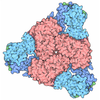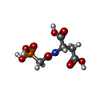[English] 日本語
 Yorodumi
Yorodumi- PDB-1i5o: CRYSTAL STRUCTURE OF MUTANT R105A OF E. COLI ASPARTATE TRANSCARBA... -
+ Open data
Open data
- Basic information
Basic information
| Entry | Database: PDB / ID: 1i5o | ||||||
|---|---|---|---|---|---|---|---|
| Title | CRYSTAL STRUCTURE OF MUTANT R105A OF E. COLI ASPARTATE TRANSCARBAMOYLASE | ||||||
 Components Components |
| ||||||
 Keywords Keywords |  TRANSFERASE / Mutant aspartate transcarbamoylase / T-state / PALA at the regulatory site TRANSFERASE / Mutant aspartate transcarbamoylase / T-state / PALA at the regulatory site | ||||||
| Function / homology |  Function and homology information Function and homology information aspartate carbamoyltransferase complex / pyrimidine nucleotide biosynthetic process / aspartate carbamoyltransferase complex / pyrimidine nucleotide biosynthetic process /  aspartate carbamoyltransferase / aspartate carbamoyltransferase /  aspartate carbamoyltransferase activity / aspartate carbamoyltransferase activity /  amino acid binding / glutamine metabolic process / protein homotrimerization / 'de novo' UMP biosynthetic process / 'de novo' pyrimidine nucleobase biosynthetic process / zinc ion binding ... amino acid binding / glutamine metabolic process / protein homotrimerization / 'de novo' UMP biosynthetic process / 'de novo' pyrimidine nucleobase biosynthetic process / zinc ion binding ... aspartate carbamoyltransferase complex / pyrimidine nucleotide biosynthetic process / aspartate carbamoyltransferase complex / pyrimidine nucleotide biosynthetic process /  aspartate carbamoyltransferase / aspartate carbamoyltransferase /  aspartate carbamoyltransferase activity / aspartate carbamoyltransferase activity /  amino acid binding / glutamine metabolic process / protein homotrimerization / 'de novo' UMP biosynthetic process / 'de novo' pyrimidine nucleobase biosynthetic process / zinc ion binding / identical protein binding / amino acid binding / glutamine metabolic process / protein homotrimerization / 'de novo' UMP biosynthetic process / 'de novo' pyrimidine nucleobase biosynthetic process / zinc ion binding / identical protein binding /  cytosol / cytosol /  cytoplasm cytoplasmSimilarity search - Function | ||||||
| Biological species |   Escherichia coli (E. coli) Escherichia coli (E. coli) | ||||||
| Method |  X-RAY DIFFRACTION / X-RAY DIFFRACTION /  MOLECULAR REPLACEMENT / Resolution: 2.8 Å MOLECULAR REPLACEMENT / Resolution: 2.8 Å | ||||||
 Authors Authors | Macol, C.P. / Tsuruta, H. / Stec, B. / Kantrowitz, E.R. | ||||||
 Citation Citation |  Journal: Nat.Struct.Biol. / Year: 2001 Journal: Nat.Struct.Biol. / Year: 2001Title: Direct structural evidence for a concerted allosteric transition in Escherichia coli aspartate transcarbamoylase. Authors: Macol, C.P. / Tsuruta, H. / Stec, B. / Kantrowitz, E.R. #1:  Journal: Biochemistry / Year: 1990 Journal: Biochemistry / Year: 1990Title: Structural Consequences of Effector Binding to the T State of Aspartate Carbamoyltransferase: Crystal Structures of the Unligated and ATP- and CTP-complexed Enzymes at 2.6-A Resolution. Authors: Stevens, R.C. / Gouaux, J.E. / Lipscomb, W.N. | ||||||
| History |
|
- Structure visualization
Structure visualization
| Structure viewer | Molecule:  Molmil Molmil Jmol/JSmol Jmol/JSmol |
|---|
- Downloads & links
Downloads & links
- Download
Download
| PDBx/mmCIF format |  1i5o.cif.gz 1i5o.cif.gz | 195.2 KB | Display |  PDBx/mmCIF format PDBx/mmCIF format |
|---|---|---|---|---|
| PDB format |  pdb1i5o.ent.gz pdb1i5o.ent.gz | 154.8 KB | Display |  PDB format PDB format |
| PDBx/mmJSON format |  1i5o.json.gz 1i5o.json.gz | Tree view |  PDBx/mmJSON format PDBx/mmJSON format | |
| Others |  Other downloads Other downloads |
-Validation report
| Arichive directory |  https://data.pdbj.org/pub/pdb/validation_reports/i5/1i5o https://data.pdbj.org/pub/pdb/validation_reports/i5/1i5o ftp://data.pdbj.org/pub/pdb/validation_reports/i5/1i5o ftp://data.pdbj.org/pub/pdb/validation_reports/i5/1i5o | HTTPS FTP |
|---|
-Related structure data
| Related structure data | 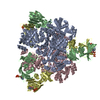 5at1S S: Starting model for refinement |
|---|---|
| Similar structure data |
- Links
Links
- Assembly
Assembly
| Deposited unit | 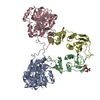
| ||||||||||||
|---|---|---|---|---|---|---|---|---|---|---|---|---|---|
| 1 | 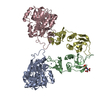
| ||||||||||||
| Unit cell |
| ||||||||||||
| Components on special symmetry positions |
| ||||||||||||
| Details | Deposited data for two catalytic and two regulatory chains Biological assembly: dodecamer can be obtained by application of the threefold crystallographic symmetry |
- Components
Components
| #1: Protein | Mass: 34250.992 Da / Num. of mol.: 2 / Mutation: R105A Source method: isolated from a genetically manipulated source Source: (gene. exp.)   Escherichia coli (E. coli) / Gene: PYRB, PYRI / Plasmid: PEK76 / Production host: Escherichia coli (E. coli) / Gene: PYRB, PYRI / Plasmid: PEK76 / Production host:   Escherichia coli (E. coli) / Strain (production host): EK1104 / References: UniProt: P0A786, Escherichia coli (E. coli) / Strain (production host): EK1104 / References: UniProt: P0A786,  aspartate carbamoyltransferase aspartate carbamoyltransferase#2: Protein | Mass: 17143.625 Da / Num. of mol.: 2 Source method: isolated from a genetically manipulated source Source: (gene. exp.)   Escherichia coli (E. coli) / Gene: PYRB, PYRI / Plasmid: PEK76 / Production host: Escherichia coli (E. coli) / Gene: PYRB, PYRI / Plasmid: PEK76 / Production host:   Escherichia coli (E. coli) / Strain (production host): EK1104 / References: UniProt: P0A7F3 Escherichia coli (E. coli) / Strain (production host): EK1104 / References: UniProt: P0A7F3#3: Chemical | #4: Chemical | ChemComp-PAL / | #5: Water | ChemComp-HOH / |  Water Water |
|---|
-Experimental details
-Experiment
| Experiment | Method:  X-RAY DIFFRACTION / Number of used crystals: 1 X-RAY DIFFRACTION / Number of used crystals: 1 |
|---|
- Sample preparation
Sample preparation
| Crystal | Density Matthews: 2.99 Å3/Da / Density % sol: 58.9 % | |||||||||||||||||||||||||
|---|---|---|---|---|---|---|---|---|---|---|---|---|---|---|---|---|---|---|---|---|---|---|---|---|---|---|
Crystal grow | Temperature: 293 K / Method: microdialysis / pH: 5.7 Details: Tris buffer, maleic acid, pH 5.7, MICRODIALYSIS, temperature 293K | |||||||||||||||||||||||||
| Crystal grow | *PLUS Temperature: 20 ℃ / pH: 5.75 / Details: Jin, L., (2000) Biochemistry, 39, 8058. | |||||||||||||||||||||||||
| Components of the solutions | *PLUS
|
-Data collection
| Diffraction | Mean temperature: 295 K |
|---|---|
| Diffraction source | Source:  ROTATING ANODE / Type: RIGAKU RU200 / Wavelength: 1.5418 Å ROTATING ANODE / Type: RIGAKU RU200 / Wavelength: 1.5418 Å |
| Detector | Type: UCSD MARK II / Detector: AREA DETECTOR / Date: Jul 25, 1996 |
| Radiation | Monochromator: GRAPHITE / Protocol: SINGLE WAVELENGTH / Monochromatic (M) / Laue (L): M / Scattering type: x-ray |
| Radiation wavelength | Wavelength : 1.5418 Å / Relative weight: 1 : 1.5418 Å / Relative weight: 1 |
| Reflection | Resolution: 2.78→30 Å / Num. all: 29390 / Num. obs: 29390 / % possible obs: 93 % / Observed criterion σ(F): 0 / Observed criterion σ(I): 0 / Redundancy: 3.08 % / Biso Wilson estimate: 26.54 Å2 / Rmerge(I) obs: 0.099 / Net I/σ(I): 5.75 |
| Reflection shell | Resolution: 2.78→2.99 Å / Redundancy: 1.85 % / Rmerge(I) obs: 0.37 / Mean I/σ(I) obs: 1 / Num. unique all: 4622 / % possible all: 75 |
| Reflection | *PLUS Num. measured all: 90537 |
- Processing
Processing
| Software |
| |||||||||||||||||||||||||
|---|---|---|---|---|---|---|---|---|---|---|---|---|---|---|---|---|---|---|---|---|---|---|---|---|---|---|
| Refinement | Method to determine structure : :  MOLECULAR REPLACEMENT MOLECULAR REPLACEMENTStarting model: 5at1 Resolution: 2.8→10 Å / Isotropic thermal model: Isotropic / Cross valid method: THROUGHOUT / σ(F): 2 / σ(I): 1 / Stereochemistry target values: Engh & Huber
| |||||||||||||||||||||||||
| Displacement parameters | Biso mean: 31.2 Å2 | |||||||||||||||||||||||||
| Refine analyze | Luzzati coordinate error obs: 0.25 Å | |||||||||||||||||||||||||
| Refinement step | Cycle: LAST / Resolution: 2.8→10 Å
| |||||||||||||||||||||||||
| Refine LS restraints |
| |||||||||||||||||||||||||
| LS refinement shell | Resolution: 2.8→2.9 Å
| |||||||||||||||||||||||||
| Software | *PLUS Name:  X-PLOR / Version: 3.1 / Classification: refinement X-PLOR / Version: 3.1 / Classification: refinement | |||||||||||||||||||||||||
| Refinement | *PLUS Highest resolution: 2.8 Å / Lowest resolution: 10 Å / σ(F): 2 / % reflection Rfree: 10 % / Rfactor all : 0.157 / Rfactor obs: 0.155 : 0.157 / Rfactor obs: 0.155 | |||||||||||||||||||||||||
| Solvent computation | *PLUS | |||||||||||||||||||||||||
| Displacement parameters | *PLUS Biso mean: 31.2 Å2 | |||||||||||||||||||||||||
| Refine LS restraints | *PLUS
| |||||||||||||||||||||||||
| LS refinement shell | *PLUS Highest resolution: 2.8 Å / Lowest resolution: 2.9 Å |
 Movie
Movie Controller
Controller


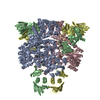
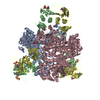
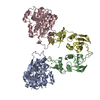

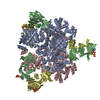
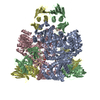
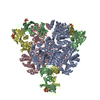


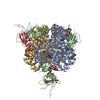
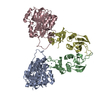
 PDBj
PDBj